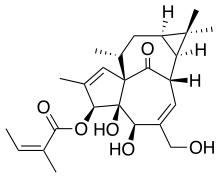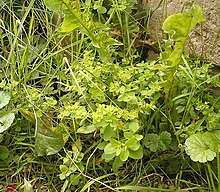Ingenol mebutate
Ingenol mebutate (ingenol-3-angelate, PEP005, LEO Pharma trade name Picato) is a substance that is found in the sap of the plant Euphorbia peplus,[1] commonly known as milkweed, and is an inducer of cell death. A gel formulation of the drug has been approved by the U.S. Food and Drug Administration (FDA)[2] and by the European Medicines Agency (EMA)[3] for the topical treatment of actinic keratosis. Two different strengths of the gel are approved for use on either the face and scalp (0.015%) or the trunk and extremities (0.05%), respectively.[4]
 | |
| Clinical data | |
|---|---|
| Trade names | Picato |
| Other names | PEP005, ingenol-3-angelate |
| AHFS/Drugs.com | picato |
| License data | |
| Pregnancy category |
|
| Routes of administration | Topical (gel) |
| ATC code | |
| Legal status | |
| Legal status |
|
| Pharmacokinetic data | |
| Bioavailability | Below detection level |
| Identifiers | |
IUPAC name
| |
| CAS Number | |
| PubChem CID | |
| DrugBank | |
| ChemSpider | |
| UNII | |
| KEGG | |
| ChEBI | |
| ECHA InfoCard | 100.214.695 |
| Chemical and physical data | |
| Formula | C25H34O6 |
| Molar mass | 430.534 g/mol g·mol−1 |
| 3D model (JSmol) | |
SMILES
| |
InChI
| |
Results from four multicenter, randomized, double-blind studies have shown that ingenol mebutate gel applied topically, for 2 to the trunk or 3 days to the face or scalp, is effective for field treatment of actinic keratoses.[5][6]
A twelve-month follow-up study was performed on actinic keratosis patients who had been treated with ingenol mebutate, 108 of which had been treated for face or scalp and 71 for trunk or extremities and the study found that of those treated for the face or scalp 46.1% had sustained clearance, and of those treated for the trunk 44.0% had sustained clearance for the period of the study.[7]
Adverse effects
Irritation of the application site is very common. The various types of irritation include redness, scaling, crusting, pain, severe itching, and sometimes infection. Additional possible side effects include eye irritation, such as periorbital edema (3% of patients in studies), headaches (2%) and nasopharyngitis (running nose, 2%).[8]
Allergic reactions, shingles, changes in pigmentation at application site, chemical conjunctivitis, and corneal burns may also occur.[9][10]

Interactions
As ingenol mebutate is not effectively absorbed through the skin and into the bloodstream, interactions with oral drugs are unlikely.[6][11]
Chemistry
The substance is an ester of the diterpene ingenol and angelic acid. A 3-step semisynthesis of ingenol mebutate starting from ingenol was described by a chemical research group in Denmark in 2012.[12] A 14-step synthesis of (+)-ingenol from (+)-3-carene, which is a relatively inexpensive constituent of turpentine, was published in July 2013.[13]
Mechanism of action
The mechanism by which ingenol mebutate causes cell death is still not fully understood. One study on squamous cell carcinoma, the precursor of which is actinic keratosis, cultures found that the PKC/MEK/ERK signaling pathway is involved in causing cell death after treatment with ingenol mebutate. In addition, the interleukin decoy receptors IL1R2 and IL13RA2 were induced, resulting in a reduction in the long-term viability of the cells, which could help prevent recurrence.[14]
Research
HIV
Ingenol mebutate has also been found to be useful for reactivating latent HIV virus in cells taken from individuals who have tested negative for signs of the disease following extended courses of anti-retroviral drugs, raising the possibility that this drug may be used to expose the last traces of virus, and thus potentially provide a permanent cure for HIV infection. Research is ongoing to determine whether the effects observed in vitro are also seen in animal models, with a view to eventual human trials for this application.[15]
Tattoo removal
A placebo-controlled study on hairless mice found that 0.1% ingenol mebutate gel was able to remove two-week-old tattoos consistently. It was observed that the microspheres within the skin containing the dye would exude into the scab intact and slough off as the skin healed about 20 days after treatment began. This mechanism appears to be independent of ink color, unlike laser tattoo removal, which is less effective for certain colors. Human trials have not yet been conducted.[16]
See also
- Thapsigargin
- Tigilanol tiglate
References
- Fallen RS, Gooderham M (2012). "Ingenol mebutate: An introduction". Skin Therapy Lett. 17 (2): 1–3. PMID 22358305.
- Picato Drug Details at Drugs@FDA
- European Public Assessment Report (EPAR) for Picato
- Picato® Gel label at Drugs@FDA
- Lebwohl M, Swanson N, Anderson LL, Melgaard A, Xu Z, Berman B (2012). "Ingenol Mebutate Gel for Actinic Keratosis". N Engl J Med. 366 (11): 1010–1019. doi:10.1056/NEJMoa1111170. PMID 22417254.
- Picato FDA Professional Drug Information
- Lebwohl M, Shumack S, Gold L (2013). "Long-term Follow-up Study of Ingenol Mebutate Gel for the Treatment of Actinic Keratoses". JAMA Dermatology. 149 (6): 666–670. doi:10.1001/jamadermatol.2013.2766.
- Drugs.com: Picato Side Effects in Detail
- "Picato (ingenol mebutate) Gel: Drug Safety Communication - FDA Warns of Severe Adverse Events, Requires Label Changes". 2015-08-21. Retrieved 24 August 2015.
- "Picato (Ingenol Mebutate): Side Effects, Interactions, Warning, Dosage & Uses". RxList. Retrieved 2018-12-06.
- Haberfeld, H, ed. (2013). Austria-Codex (in German). Vienna: Österreichischer Apothekerverlag.
- Liang, X.; Grue-Sørensen, G.; Petersen, A. K.; Högberg, T. (2012), "Semisynthesis of Ingenol 3-Angelate (PEP005): Efficient Stereoconservative Angeloylation of Alcohols", SYNLETT (23): 2647–2652. https://www.thieme-connect.com/products/ejournals/pdf/10.1055/s-0032-1317415.pdf
- Jorgensen, L.; McKerrall, S. J.; Kuttruff, C. A.; Ungeheuer, F.; Felding, J.; Baran, P. S. (2013). "14-Step Synthesis of (+)-Ingenol from (+)-3-Carene". Science. 341 (6148): 878–882. doi:10.1126/science.1241606. PMID 23907534.
- Freiberger S (2015). "Ingenol Mebutate Signals via PKC/MEK/ERK in Keratinocytes and Induces Interleukin Decoy Receptors IL1R2 and IL13RA2". Molecular Cancer Therapeutics. 14 (9): 2132–2142. doi:10.1158/1535-7163.mct-15-0023-t.
- Jiang G, Mendes EA, Kaiser P, Wong DP, Tang Y, Cai I, et al. (2015). "Synergistic Reactivation of Latent HIV Expression by Ingenol-3-Angelate, PEP005, Targeted NF-kB Signaling in Combination with JQ1 Induced p-TEFb Activation". PLoS Pathogens. 11 (7): e1005066. doi:10.1371/journal.ppat.1005066. PMC 4520526.
- Cozzi S (2017). "Tattoo Removal with Ingenol Mebutate". Clinical, Cosmetic and Investigational Dermatology. 10: 205–210. doi:10.2147/ccid.s135716.